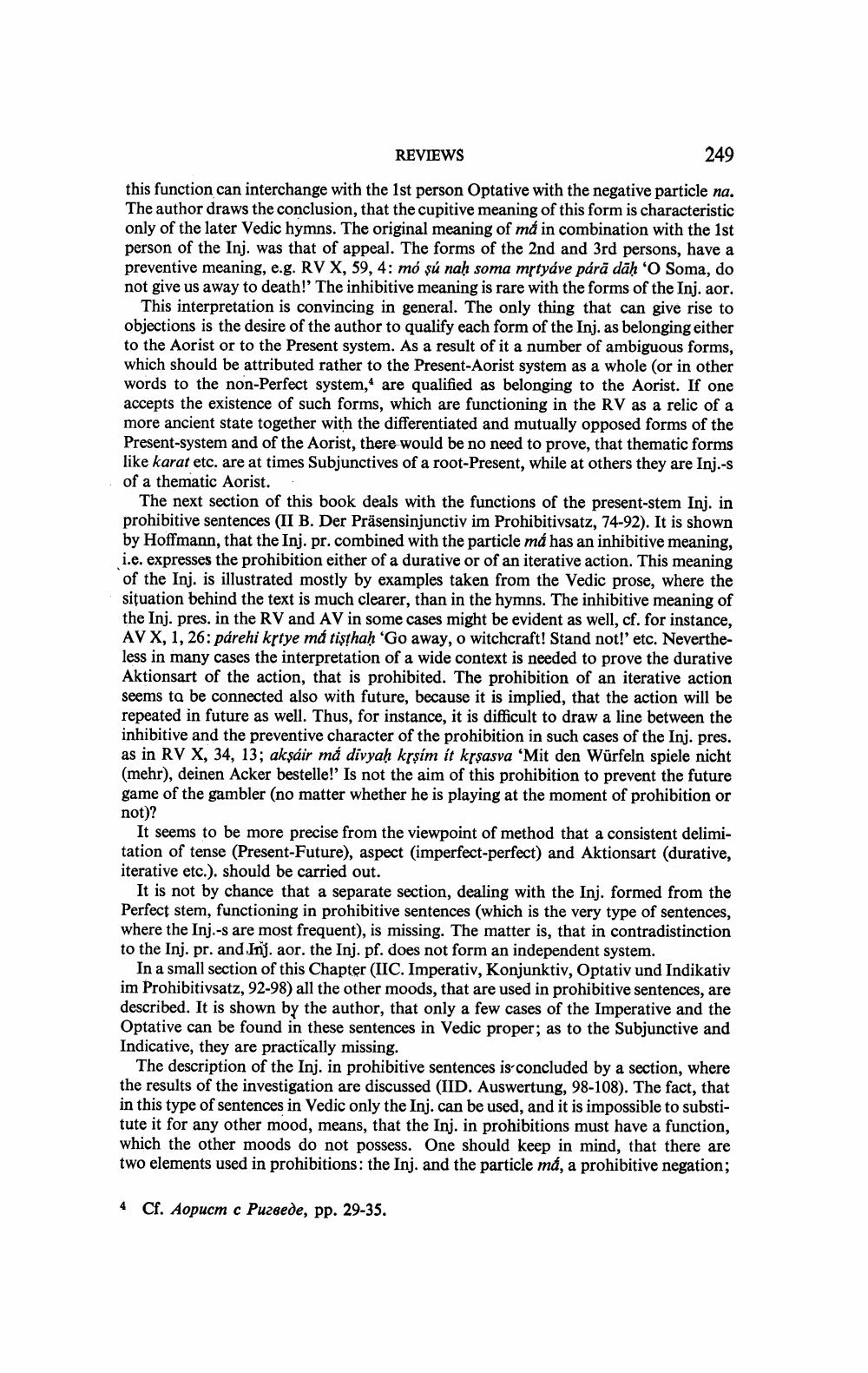Book Title: Reviews Of Different Books Author(s): Publisher: View full book textPage 3
________________ REVIEWS 249 this function can interchange with the 1st person Optative with the negative particle na. The author draws the conclusion, that the cupitive meaning of this form is characteristic only of the later Vedic hymns. The original meaning of ma in combination with the 1st person of the Inj. was that of appeal. The forms of the 2nd and 3rd persons, have a preventive meaning, e.g. RVX, 59, 4: mo su nah soma mrtyave para dah 'O Soma, do not give us away to death!' The inhibitive meaning is rare with the forms of the Inj. aor. This interpretation is convincing in general. The only thing that can give rise to objections is the desire of the author to qualify each form of the Inj. as belonging either to the Aorist or to the Present system. As a result of it a number of ambiguous forms, which should be attributed rather to the Present-Aorist system as a whole (or in other words to the non-Perfect system," are qualified as belonging to the Aorist. If one accepts the existence of such forms, which are functioning in the RV as a relic of a more ancient state together with the differentiated and mutually opposed forms of the Present-system and of the Aorist, there would be no need to prove, that thematic forms like karat etc. are at times Subjunctives of a root-Present, while at others they are Inj.-s of a thematic Aorist. The next section of this book deals with the functions of the present-stem Inj. in prohibitive sentences (II B. Der Prasensinjunctiv im Prohibitivsatz, 74-92). It is shown by Hoffmann, that the Inj. pr. combined with the particle ma has an inhibitive meaning, i.e. expresses the prohibition either of a durative or of an iterative action. This meaning of the Inj. is illustrated mostly by examples taken from the Vedic prose, where the situation behind the text is much clearer, than in the hymns. The inhibitive meaning of the Inj. pres. in the RV and AV in some cases might be evident as well, cf. for instance, AVX, 1, 26: parehi krtye ma tisthah 'Go away, o witchcraft! Stand not!' etc. Nevertheless in many cases the interpretation of a wide context is needed to prove the durative Aktionsart of the action, that is prohibited. The prohibition of an iterative action seems to be connected also with future, because it is implied, that the action will be repeated in future as well. Thus, for instance, it is difficult to draw a line between the inhibitive and the preventive character of the prohibition in such cases of the Inj. pres. as in RV X, 34, 13; aksair ma divyah krsim it krsasva 'Mit den Wurfeln spiele nicht (mehr), deinen Acker bestelle!' Is not the aim of this prohibition to prevent the future game of the gambler (no matter whether he is playing at the moment of prohibition or not)? It seems to be more precise from the viewpoint of method that a consistent delimitation of tense (Present-Future), aspect imperfect-perfect) and Aktionsart (durative, iterative etc.). should be carried out. It is not by chance that a separate section, dealing with the Inj. formed from the Perfect stem, functioning in prohibitive sentences (which is the very type of sentences, where the Inj.-s are most frequent), is missing. The matter is, that in contradistinction to the Inj. pr. and Inj. aor. the Inj. pf. does not form an independent system. In a small section of this Chapter (IIC. Imperativ, Konjunktiv, Optativ und Indikativ im Prohibitivsatz, 92-98) all the other moods, that are used in prohibitive sentences, are described. It is shown by the author, that only a few cases of the Imperative and the Optative can be found in these sentences in Vedic proper; as to the Subjunctive and Indicative, they are practically missing. The description of the Inj. in prohibitive sentences is concluded by a section, where the results of the investigation are discussed (IID. Auswertung, 98-108). The fact, that in this type of sentences in Vedic only the Inj. can be used, and it is impossible to substitute it for any other mood, means, that the Inj. in prohibitions must have a function, which the other moods do not possess. One should keep in mind, that there are two elements used in prohibitions: the Inj. and the particle ma, a prohibitive negation; . The matt of this ch "nj. pf. does 4 Cf. Aopucm c Puzeede, pp. 29-35.Page Navigation
1 2 3 4 5 6 7 8 9 10 11 12 13 14 15 16 17 18 19 20 21 22 23 24 25 26 27 28 29 30 31 32 ... 48
